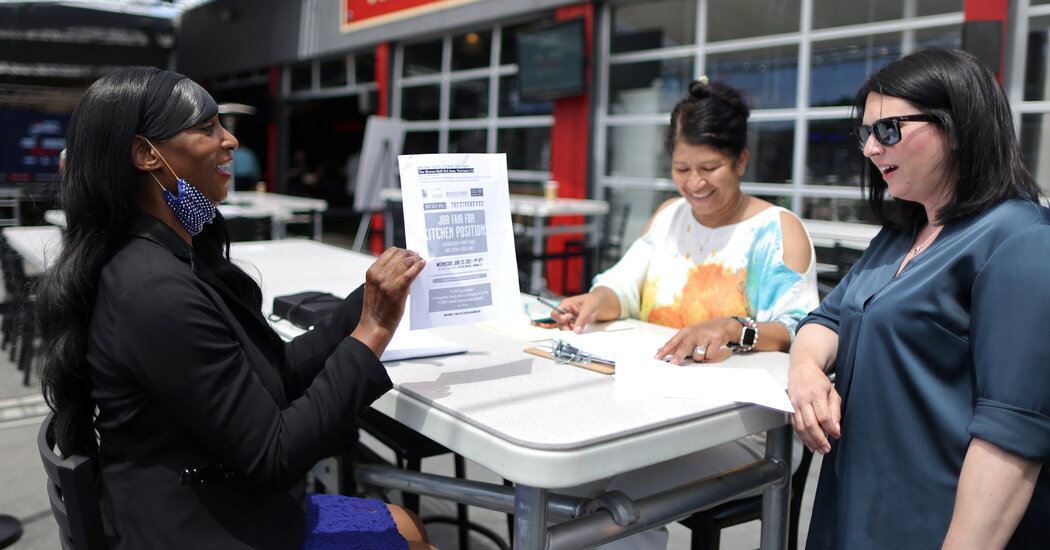
August Jobs Report Is Expected to Show Healthy Gain

Daily Business Briefing
Sept. 3, 2021, 5:07 a.m. ET
Sept. 3, 2021, 5:07 a.m. ET

The American economy’s health — and the impact of the latest coronavirus surge — will come into sharper focus Friday morning when the government releases data on hiring and employment in August.
The Labor Department is expected to report a gain of 725,000 jobs, according to economists polled by Bloomberg, a bit slower than the rip-roaring pace of more than 900,000 recorded in June and July, but a healthy gain by most measures.
Still, with the Delta variant of the coronavirus bringing new restrictions in many parts of the country, a slowdown in some of the fastest-growing industries, like leisure and hospitality, is possible. Dining out and travel boomed in early summer as Americans emerged from more than a year of lockdowns, and experts are watching for a retreat.
“Delta is a game-changer,” said Diane Swonk, chief economist at Grant Thornton, an accounting firm in Chicago. “It’s not that people are laying off workers in reaction to Delta. But people are pulling back on travel and tourism and going out to eat, and that has consequences.”
Restaurant reservations on OpenTable were close to normal levels earlier in the summer, but are now 10 percent below where they were before the pandemic. There has also been a sharp decline in hours worked at restaurants and entertainment venues, according to data from Homebase, which provides time-management software to small businesses.
The data being reported Friday was collected in the second week of August, so it may not reflect the full extent of the Delta spread or the impact of Hurricanes Henri and Ida in the second half of the month.
Supply chain disruptions and a lack of parts like semiconductors have upended production for automakers and other manufacturers. At the same time, employers have complained about a shortage of job candidates, and wages among lower-paid employees have jumped. Walmart announced Thursday that it was raising hourly pay for more than half a million workers.
For the nearly nine million Americans who are out of work, robust hiring is essential if unemployment is to drop from its July level of 5.4 percent to the 3.5 percent rate that prevailed before the pandemic. The plight of the jobless is compounded by the expiration of federally funded unemployment benefits after this week, which will affect an estimated 7.5 million people.

Federal Reserve officials will be keenly watching the fresh employment data that’s due later on Friday as they try to assess whether the job market has healed enough for the central bank to begin inching away from full-blast monetary support for the economy.
The Fed has been buying $120 billion in government-backed bonds each month to keep longer-term interest rates low and many types of borrowing cheap, bolstering lending and spending to help the economy heal. Officials are debating when and how to pare back those bond purchases, and investors are looking for an announcement about the planned start of the so-called taper at one of the Fed’s coming meetings.
But central bankers have tied their policy path closely to the labor market, suggesting that the economy has not yet quite achieved the “substantial further progress” they had hoped to see on the jobs front. Officials including Jerome H. Powell, the Fed chair, have signaled that although the economy has made adequate strides toward the central bank’s inflation goal to justify a slowdown in bond buying, they would like to see continued job gains before they feel confident in removing support.
“They believe we’ve met substantial further progress for inflation,” said Matthew Luzzetti, chief U.S. economist at Deutsche Bank. “We’re just waiting on meeting that threshold for the labor market.”
Mr. Powell said during a speech last week that as of the Fed’s July meeting, he and most of his colleagues thought the Fed could start reducing the pace of asset purchases this year if the economy performed as they expected.
“The intervening month has brought more progress in the form of a strong employment report for July, but also the further spread of the Delta variant,” Mr. Powell added, saying that the Fed would be “carefully assessing incoming data and the evolving risks.”
The Fed has other tools to support the economy, even after it begins to slow its bond purchases. The central bank’s main policy interest rate, which guides short-term borrowing costs and affects consumer rates from mortgages to car loans, is at rock bottom and is likely to stay there for months or even years.
But slowing bond purchases will be the first step toward a more normal policy setting, and a sign that the Fed thinks the economy has come through the turbulent pandemic lockdown period and is making strong progress toward a full recovery.
The central bank is tiptoing gingerly when it comes to removing policy support compared to after past recessions: The unemployment rate is expected to drop to 5.2 percent in the August report, based on the median forecast in a Bloomberg survey, and is likely to be substantially lower by the time the Fed increases rates. After the 2008 recession, the Fed had finished tapering and raised rates in late 2015, when joblessness was around 5 percent.
The slower reaction this time comes in part because economic conditions have been evolving so quickly. But more than that, many policymakers have come to see the Fed’s decision to start raising interest rates in 2015 — before the labor market was operating at full speed or inflation had stabilized — as a mistake. The Fed formally reworked its policy approach last year, laying out a more patient game plan and qualifying its employment target as a “broad-based and inclusive goal.”
The best indicator of the economy’s health is the Labor Department’s monthly jobs report. Here’s how to decode it:
What is the jobs report based on?
The jobs report is based on two surveys.
One counts people, and the other counts jobs. They generally point to parallel trends, but there are some notable differences.
The household survey counts how many people are in the labor force — either working or actively looking for work.
Lately that’s been around 161 million, still fewer than before the pandemic.
The number that gets the most attention — the overall increase or decrease in jobs — comes from the survey of employers. Before the pandemic, a gain of 100,000 to 200,000 would be considered solid. But with the economy still nearly six million jobs short of where it was before the pandemic, it takes a bigger increase for a report to qualify as good news.
So far this year, the monthly gains have averaged about 600,000.
What is the unemployment rate?
The unemployment rate is the percentage of those people who aren’t working. Early last year, that rate was at its lowest point in decades — 3.5 percent. When the pandemic hit, it shot up to 14.8 percent. It has fallen steadily since then, to 5.4 percent in July.
If the unemployment rate goes up, that isn’t always purely bad news.
Sometimes the number goes down because people have stopped looking for work, so they aren’t counted as part of the labor force.
And sometimes the unemployment rate goes up because more people have decided to look for work but haven’t found a job yet. That can signal economic optimism.
How accurate is the jobs report?
In a fast-moving economy, the numbers behind the monthly jobs report are a bit dated. The household survey is generally conducted on the calendar week that includes the 12th of the month, and the survey of employers is taken in the pay period that includes the 12th.
The employer survey, with a bigger sample, is considered more reliable. But it does not take into account the self-employed, unpaid family workers, domestic help or agricultural workers.
Generally, the numbers are seasonally adjusted. That means the effects of ordinary weather changes, major holidays and school schedules are removed so that underlying trends are more evident.

If there is such a thing as an It Girl in venture capital these days, Li Jin would fill the bill. She sits at the intersection of start-up investing and the fast-growing ecosystem of online creators, both of which are red hot.
She formed her own venture firm, Atelier Ventures, last year and has raised a relatively small $13 million for a fund, but Ms. Jin was among the first investors in Silicon Valley to take influencers seriously and has written about and backed creators for years, Taylor Lorenz reports for The New York Times.
A Harvard graduate who was inspired by the ideas of Friedrich Engels and Karl Marx, Ms. Jin, 31, is also aggressively pro-worker. She has made it clear in podcasts and her Substack newsletter that creators should get the same rights as other workers. Among the ideas she has championed is a “universal creative income,” which would guarantee creators a base amount of money to live on.
Now as large venture capital firms flock to influencer start-ups, and as Facebook, YouTube and others introduce $1 billion creator funds, Ms. Jin’s track record has made her a go-to business guru for many digital stars who are trying to navigate the fast-changing landscape.
Hank Green, 41, a top creator on YouTube and TikTok, said he often tossed ideas back and forth with her by phone. Markian Benhamou, 23, a YouTuber with more than 1.4 million subscribers, credited her with understanding what creators go through. Marina Mogilko, 31, a YouTube creator in Los Altos, Calif., said Ms. Jin “started the whole creator economy movement in Silicon Valley.”
“She was talking about the creator economy years and years and years before anyone else was,” said Jack Conte, a co-founder and the chief executive of Patreon, a crowdfunding site for content creators. “She really sees the future before other people do.”
Source: https://www.nytimes.com/live/2021/09/03/business/economy-stock-market-news/


















